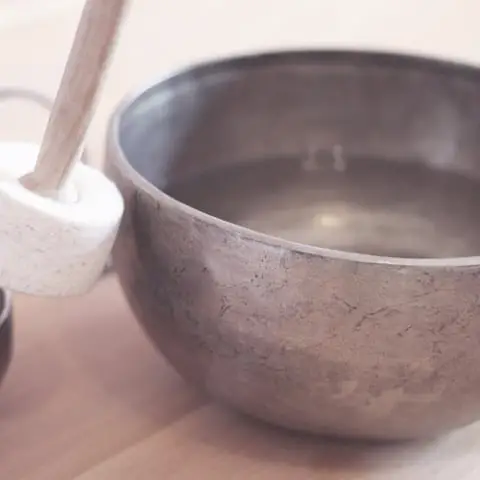Meditation using a singing bowl has been commonplace for centuries in the Eastern world where the concept was developed and has become popular in Western nations in the last few decades. A singing bowl can help you focus and dive deeper into a meditative state. The sound of the tones and the action of using the singing bowl can help you find a more relaxed and focused meditative state.
If you are new to using a singing bowl in your meditation, it can be a little confusing. You know you have a bowl and a striker and that they work together to create sounds, but how does the bowl (and the sound it makes) help you reach a powerful, reflective state that will ease your stress, improve your focus, and relax your body?
There are a few different ways to use a singing bowl when you meditate. You can use the bowl in private meditation by making the sounds yourself or in guided meditation by allowing someone else to play the bowl while you meditate. Using a meditation bowl comes down to two very simple steps – holding the bowl correctly and creating the soothing, melodic sounds.
Holding Your Singing Bowl Properly
The first step in using a singing bowl is learning to hold it properly. Typically, meditators either hold the bowl in their hand or place it on a table in front of them. The method you use depends on the size of the bowl, the striker you are using, and your personal preference:
- If your bowl is smaller and not too heavy, holding it in your hand is likely your better option.
- If you are using a heavy striker or striking the bowl with a more forceful blow, you will also want to hold the bowl in your hand to keep it from falling off the pad.
- If you are using a large bowl that isn’t easy to balance in one hand, placing the bowl on a table is preferable.
- If your striker is light enough or you are not striking it very hard, placing the bowl on the table will be easier.
How to Hold a Singing Bowl in Your Hand
If you choose to hold the bowl in your hand, you will only need your singing bowl and striker.
Then, follow these steps:

- Hold one hand out in front of you, preferably rested on something so that you are relaxed.
- If you are sitting on the floor or a sofa, rest the hand on your knee.
- If you are sitting at a table, rest your hand on the table.
- Place the bowl flat in the palm of your hand. If the bowl is particularly small, balance it on your fingertips.
- Use the softest hold you can. If your hand makes too much contact with the bowl, it will not sing as well because you will be blocking the sound.
- With a smaller bowl that requires you to hold it with your fingertips, balance it as gently as possible.
Note: If you are wearing rings, take them off, as they will vibrate against the bowl and make a harsh sound.
How to Place a Singing Bowl on Your Table
If you choose to place the bowl on a table, you will need:

- A singing bowl
- A pad or cushion
- A table
- A striker
Then, follow these steps:
- Place the cushion on the table in front of you within easy reach.
- Place the bowl in the center of the cushion.
Note: Do not place the bowl directly onto a hard surface because the sound from the bowl will be unpleasant as it vibrates against the surface beneath it.
Creating a Tone with Your Singing Bowl
There are two ways to create entrancing melodies using a singing bowl:
- You can strike your bowl with a striker to elicit a single focal tone that fades out slowly;
- You can ‘play’ the bowl to bring out a variety of tones that build over time.
How to Strike Your Singing Bowl
The simplest way to use a singing bowl is to tap it lightly with a striker. Little practice is required for this method, although where you hit the bowl with your striker will impact the sound you generate. The size of the singing bowl will also affect the sound.
Here is how to meditate when striking your singing bowl:

Strike the bowl lightly. Using your striker, gently strike the bowl at the widest part of the bowl. You are not trying to tap at the top or bottom of the bowl, but rather the curved part of the bowl about halfway down. It may take some experimentation to determine the right part of the bowl to strike, as well as the right amount of effort to expend striking the bowl.
If the bowl is in your hand, it is easier to strike the bowl with a little more force. This will create a louder sound that will resonate for a longer time. If the bowl is on a pad in front of you, do not use as much force because the strike could cause the bowl to come off the pad. Leaving the pad could cause the bowl to make a harsh sound, which will make it more difficult for you to focus and meditate.Focus on the pure tone as you meditate. The tone created when you strike your singing bowl will provide the focal point that you will use in your meditation. The tone will be sustained, and during this time, you will be going deep into a meditative state.
After you strike the bowl, focus intently on the sound. Block out all other thoughts and noises and fully commit your mind to the single-toned chime coming from the bowl. This sound will fade out slowly over time.
- Come out of deep meditation. As the tone subsides, you will rise gently out of your deep meditative state. The point when you can no longer hear the tone is the release from the external.
- (Optional) If you are continuing to meditate, strike the bowl again. Suppose you are going to continue through several cycles of meditation. In that case, you can strike the bowl again and re-enter deep meditation.
- Calm the bowl with your hand when you are done meditating. When you are finishing meditation, place your free hand softly on the side of the bowl to calm the vibrations and quiet the tone. A soft touch is required to allow the tone to die out gradually, rather than all at once.
How to Make Your Singing Bowl Sing
To make a bowl generate the continuous tone for which singing bowls are named requires slightly more skill and effort. Many meditation experts consider the physical action involved in making the bowl sing to be part of the focus needed for deep meditation. If you are making your bowl sing, the sound will not die out until you stop playing it.
Here is how to meditate while making your bowl sing: (Optional) Strike the bowl lightly with your striker. Many people who use singing bowls to meditate like to begin by striking the bowl to produce an initial tone. A light tap is enough to get the noise started. This initial strike will make it easier to produce a tone and will require less effort and time to get the singing tone from your bowl.
If you are skilled at playing a singing bowl, you may be able to skip the first strike and simply start playing. Run the striker gently around the outside of the bowl at the upper rim. Do not run the striker on the rim itself. Keep a gentle but constant amount of pressure on the bowl to coax the sound out of the bowl.
It may take several revolutions around the rim of the bowl to begin building the tones. As you rub the striker around the outside rim of the bowl, the sound will build. The tone will stay at an even pitch but build in volume. Depending on the striker used and the bowl itself, the bowl’s song may contain overlapping tones. Continue to focus on the sound and the movement of your hand, blocking out all other thoughts. Keep your hand centered above the bowl. The only motion should be your wrist moving as you rub the striker slowly around the outside of the bowl. This will minimize any physical motion that could remove you from your state of focus and help you sink further into a meditative state. Focus on the building sound and the subtle movements of your hand as it moves the striker around the bowl.
Control your breathing. Slow, deep breathing will help you maintain a deep meditative state. Breathe in as your striker circles half of the rim and breathe out on the other half. Direct your focus on the tone you are creating, your timed breathing, and the subtle movements of your wrist as it guides the striker around the rim of the bowl.
Come out of deep meditation. When you are finished meditating, remove the striker from the rim of the bowl and set it down gently.
You can let the sound fade out as you come out of your meditation, or you can gently place an open hand against the side of the bowl. The touch of your hand will allow the sound to fade evenly, which will maintain the relaxation and stress reduction you have accomplished with your meditation.
Additional Options for Meditation with a Singing Bowl
The instructions above will allow you to begin your journey toward meditating with a singing bowl. Once you have mastered the basics of striking and playing your singing bowl, you may want to experiment with adding water to your singing bowl or trying guided meditation.
Adding Water to Your Singing Bowl
A singing bowl is more than capable of making beautiful, sustained tones with just the bowl and a striker. Some meditators, however, add water to their singing bowl for different effects than they would get with an empty bowl.
Playing a singing bowl with water inside it is called charging the water. The charged water affects the vibration frequency of the bowl and creates different sounds than you might otherwise be able to achieve. Various levels of water will produce different tones.
Another possible effect of charging water in your singing bowl is seeing the water dance. The vibrations of the bowl move into the water, and as the vibrations build in strength, they force the water to move from every direction.
Charging water with a singing bowl results in water that appears to boil, with droplets of water leaping out of the standing water before splashing back down. The musical effect is similar to listening to light rainfall.
Follow these steps to charge water in your singing bowl:

- Place water in the bowl. It is recommended not to fill the bowl more than halfway, as it could dampen the tones and may result in the water spilling out of the bowl.
- Hold the bowl level or place it on a mat. The bowl needs to be stable to maintain the vibrations necessary to produce a consistent, clear tone. Rest your hand on something if you are holding the bowl or make sure the bowl is resting on a mat on a stable surface.
- Play the bowl normally or strike it. Playing the bowl when there is water inside will cause the vibrations of the bowl to translate to the water. The vibrations will charge the water and cause it to resonate. The interaction between the bowl and the water will create different tones than you would get without water.
- Experiment with water levels. To hear the different sounds, you can create by charging water in a singing bowl, add a teaspoon of water at a time. Make a note of the frequencies you find most pleasing for future use.
- Do not drink water charged in a metal bowl. While it may be safe to drink the water from a clean glass or crystal bowl, harmful toxins can leach into the water from a metal bowl.
Using a Singing Bowl in Guided Meditation
Another option for using a singing bowl in meditation is to try a guided meditation. Guided meditation is a wonderful way to meditate using a singing bowl.
To meditate with a singing bowl in guided meditation, you will:
- Make yourself comfortable
- Cover your eyes
- Allow someone else to play the singing bowl
One advantage of guided meditation with a singing bowl is that you will not have to perform any physical motion. When meditating alone with a singing bowl, the physical activity can help you focus. Still, some meditation experts believe that the motion of playing the singing bowl can make it harder for you to reach a meditative state.
Why Is Sound Helpful During Meditation?
Meditation experts have long sworn by the beneficial effects of using sound in meditation. For centuries, Eastern experts struck gongs or used low chants to aid their meditation. In recent years, studies have been performed to understand why specific sounds improve meditation.
A research study published in 2016 found considerable benefits to sound therapy through the use of singing bowls. For this study, patients were asked to lie comfortably for assisted meditation. The study used a variety of singing bowls for most of the trial. The study measured markers for stress, anxiety, and depression both before and after the assisted meditation.
The researchers found significant improvements in mood, tension, anxiety, and pain levels. To quote their findings: “A significant difference was found in all endpoints examined in response to the meditation.”

Other studies have also been performed and found that sound-aided meditation was more effective at improving mental and physical well-being than meditation without sound. The reason for this connection is not immediately apparent, and studies in the field continue, but there are theories with some scientific backing.
Studying psychoacoustics (the perception of sound) has resulted in some interesting results. Dr. Ifor Capel postulates that since brain waves determine the release of neurotransmitters, which are the ‘language’ the body uses to communicate internally, sound waves at certain frequencies can help the brain stimulate desirable chemicals like serotonin.
Singing bowls resonate at particular frequencies. They also produce consistent tones, as opposed to more traditional music that uses a variety of tones. According to some studies, a particular sustained tone at just the right frequency can change the speed of your brain waves and send your mind into a different state than you would usually be able to find.
The short version of these studies is that the sounds generated by singing bowls can help you achieve a deeper meditative state. Multiple clinical and scientific studies have supported that finding. But that’s just science confirming what many people have known for millennia.
Sustained tones have been associated with healing for thousands of years:
- Evidence has been found of Eastern religions using gongs and struck bells with meditation as far back as 3000 years ago.
- Egyptian priests used to sing in constant, tonal vowels to promote healing.
- Some Native American people have connected spiritual songs and healing.
Interestingly, singing bowls have only been popular since the 1970s. You may have heard of them referred to as ‘Tibetan singing bowls,’ but there is little to no evidence suggesting that singing bowls are. However, regardless of their historical legacy, it is difficult to deny that singing bowls can be an effective tool for improving meditation. With scientific and medical evidence supporting their use, singing bowls are here to stay.
The Best Singing Bowls for Meditation
With many kinds of singing bowls available, knowing the differences will help you choose the one for you. Here are some highly-recommended metal and crystal singing bowls to get you started:
Metal Singing Bowls
Metal singing bowls are the most common, despite being more difficult to play than a crystal bowl. A metal bowl is more traditional. While many countries produce handmade singing bowls, the Tibetan singing bowl is easily the most popular.
The Moukey Traditional Singing Bowl is a small bowl made of brass. Its tone is high and bright. The small bowl fits in your hand and can be carried and transported easily.
- Comes with a bowl, wooden mallet, and round cushion
- Easy to play, even for kids
- Great starter singing bowl
- Also makes a great gift
The beautiful singing bowl set features etched details and layered tones. It produces a surprisingly deep sound, given its small size. It is easy to play and a very popular choice.
- Comes with a bowl, dual-surface striker, and round cushion
- Small enough to take anywhere
- Etched, not painted, so designs will not wear off over time
This 10-inch metal singing bowl is a well-reviewed, high-end bowl. It produces a rich, layered tone using either the mallet or round striker. Built from a seven-metal alloy and hammered rather than machined, this beautiful bowl is a traditional instrument that will serve you well.
- Comes with a large bowl, padded mallet, round striker, and silk cushion
- Deep sounds that cannot be achieved with smaller bowls
- Traditional, hand-hammered finish
Crystal Singing Bowls
For a truly different sound experience, you can try a crystal singing bowl. Their tone is different from metal singing bowls, but they are still beautiful and excellent for meditation and focus. Whether you can embrace the sound of a crystal singing bowl will depend largely on the importance you place on tradition in the role of the singing bowl.
If you are new to crystal bowls and trying to decide if one is right for you, this crystal bowl is a great place to start. The white frosted singing bowl from UBTer includes a guarantee against breakage so you can dip a toe into the world of crystal singing bowls.
- Comes with one bowl, rubber O-ring, and a suede-covered striking stick
- Choose an F note or C note bowl
- Great entry point price for your first crystal bowl
For a beautiful bowl with great reviews, this frosted quartz crystal singing bowl from ENERGYSOUND is a solid choice. The tone is strong and pure. The bowl itself is large enough to set on the floor, and the song is quite loud.
- Comes with one bowl, O-ring, and a playing mallet
- The manufacturer has a variety of bowls to target different chakras, so you will be able to build matching sets with future purchases
When you are ready to embrace crystal singing bowls fully, the 8-inch frosted quartz bowl from ENERGYSOUND is your next step. The linked bowl is an F note, focusing on the heart chakra, and comes with a carrier.
- Includes a rubber mallet for striking or playing
- The carrying case allows you to store the bowl and take it with you safely
- Free return policy in case it does not suit you
Different Types of Strikers
The tool you use to strike or play your singing bowl will also greatly impact the sound your bowl produces. There are various types of strikers, and each produces unique sounds and is used in varying ways.
Most bowls you purchase online will come with a striker of some sort. However, if you want to customize your meditation, you might experiment with different kinds of strikers.
There are many striker options available that will produce various tones and be used in different ways:
- Round Tibetan striker. The traditional Tibetan striker is a thick cylinder with fabric or leather wrapped around one end. This is the most common type of striker. It can produce a clean, clear note when it strikes the bowl and a deep resonating sound when played.
- Gong mallet. For a different sound experience, you can investigate a gong mallet. These have large padded heads and make a satisfying gong sound. They work better with a large bowl and are generally used just for striking, not playing.
- Rounded mallet. An alternate tool for playing a crystal bowl, a rounded rubber mallet produces a very different tone from leather or felt striker. These can be easier to use than the traditional Tibetan striker.
- Wooden wand. For a small, simple striker that is easy to play, try a wooden wand. These do not have padding or covering at all; they are basic wooden strikers that will produce clean, clear tones.
Incorporating A Singing Bowl into Your Meditation
As you can see, incorporating sound into your meditation with a singing bowl can heighten your experience. Not only that, but there is evidence that meditation is good for both mental and physical health, which makes sound therapy using singing bowls as meditation aids is even more effective. Experience the benefits of meditation and sound therapy for yourself and open yourself to improved well-being.




